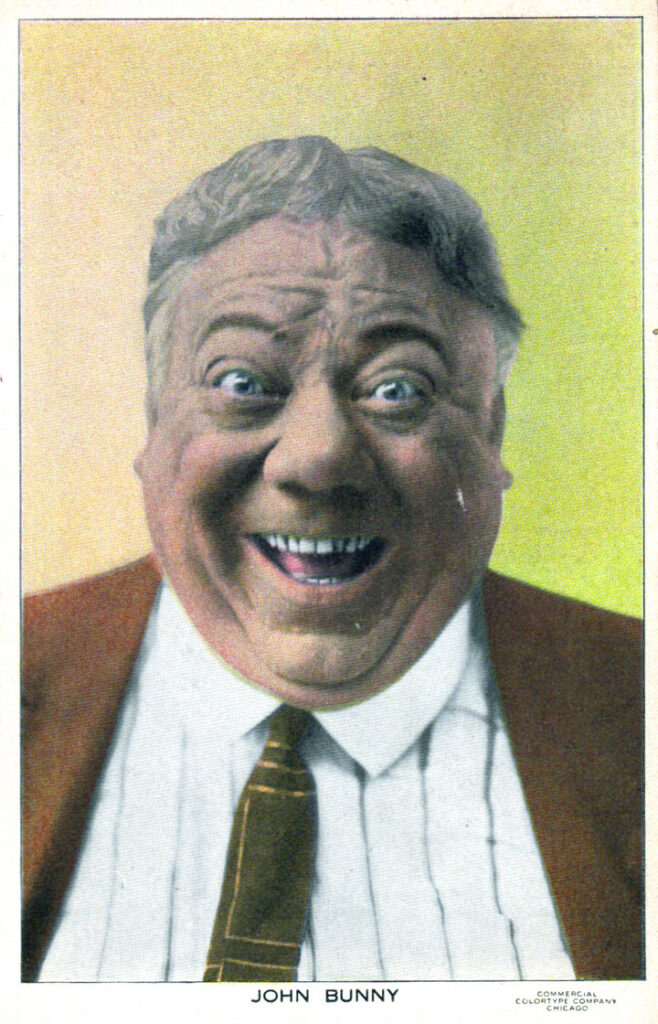John Bunny enjoyed a popularity in his day that has evaporated with time. To some extent that process began right at the end of his screen career.
The mid-‘teens saw the rise of slapstick in the manic Keystone comedies and those of Charlie Chaplin and others. The polite social, situational comedies Bunny was making in Brooklyn at Vitagraph Studios was eclipsed by these new, energetic comedies. Bunny’s passing in 1915 meant a full stop to the popular series, and their late-Victorian flavor made them cultural antiques, in a way, within a few years.
A lot of the humor and charm of the John Bunny and Floria Finch comedies lies in their performances, in the actors’ faces and small gestures. If these shorts did get revived at all in the ensuing years of the silent era, it meant they’d have been shown when projection speeds moved into the low-to-mid ‘20s of frames-per-second. This means that a lot of that subtlety would have gotten erased, and the internal thought processes that read on performers’ faces got masked in a way. This makes the films a little harder to decode and enjoy.
Over the ensuing decades, the Bunny-Finches (as they were sometimes referred to in their heyday) were seen in slightly blurry dupe prints run at 24 fps at a time when variable speed projection or telecine (video transfer) wasn’t possible. The slight over-speeding may have impaired their entertainment potential, especially when taken in the context of most silent film comedy. The technology for presenting silent films has improved in this regard in the last couple decades, but the Bunny films were not always thought of in programmers minds.

Steve Massa and I rediscovered the films in the 2000s when we were screening rare comedy shorts in the collection of the Museum of Modern Art, for the Cruel and Unusual Comedy series we were putting together with Ron Magliozzi. Watching these — as well as other Vitagraph shorts from 1911-15 — in MoMA’s sharp 35mm prints at a decent speed was a revelation. We wound up programming quite a few of the Bunny shorts for the series, and were really pleased with how well they landed with audiences.
One of our favorites was a 1914 short called Tangled Tangoists. It’s got some great performances, and a great situational concept about these two borderline seniors trying to fit in with society by learning the hottest new dance, and some very clever visuals and staging. It’s also expertly directed by George D. Baker, another Vitagraph talent whose work we’ve become huge fans of.
Throughout the film, Baker’s sense of composition and framing, use of foreground and background space, subtle direction, and grasp of silent film’s storytelling language is in great evidence. Baker had been a photographer, with a professional studio in Beatrice NE, before coming to NYC and winding up working in moving pictures.
When Steve and I got the okay from the EYE Filmmuseum to include titles they’d posted to their YouTube channel on our Silent Comedy Watch Party, Tangled Tangoists was one of a handful of titles that were at the top of our list. (Both MoMA and EYE have 35mm prints of this title.) The short’s a great introduction to the Bunny-Finch series, to the Vitagraph product, and to the hundreds of silent films in EYE’s Jean Desmet Collection.
Tangled Tangoists will be shown on episode 4 of The Silent Comedy Watch Party, which live-streams on Sunday April 12, 2020 at 3pm EDT. The show streams on YouTube, free of charge, and will be archived there in case you miss the live show. Details are on the episode 4 show page.
Considering that it seems now that theaters and cinemas will remain shuttered for a few more months, at least, we’ll definitely going back to the well for more films from the EYE Filmmuseum and from Vitagraph for The Silent Comedy Watch Party in the weeks to come. In the meantime, if you’re looking for more of these while you wait, there are two excellent options.
Tony Susnick released a DVD a few years ago called John Bunny: Film’s First King of Comedy. It contains four John Bunny films in new scans from 35mm prints preserved by the Library of Congress, as well as Tony’s new documentary about John Bunny. The DVD is available on Amazon.
Over the last several years, the EYE Filmmuseum (Netherlands) has been scanning and posting rare silent films from their archive to their YouTube channel. There are nearly 400 from the Jean Desmet Collection alone, as well as lots more, and many of these are Vitagraph shorts. You can go down a silent film rabbit-hole on their YouTube channel here.
